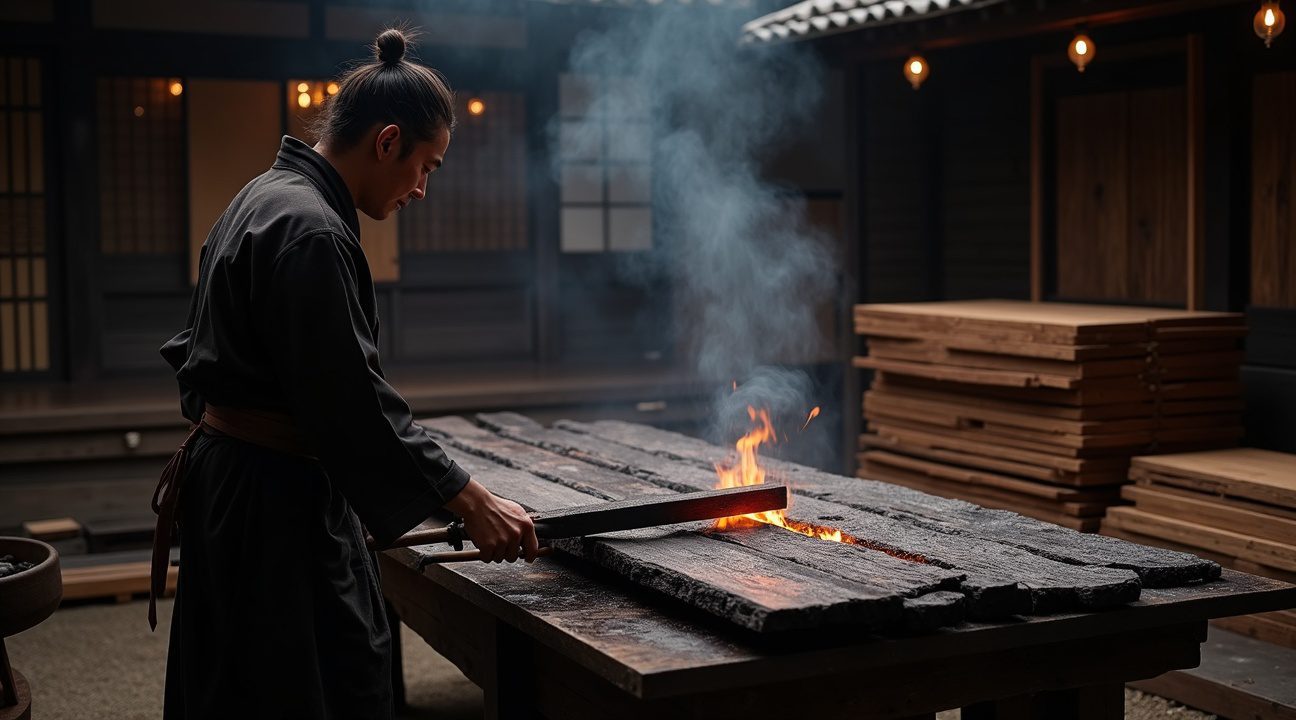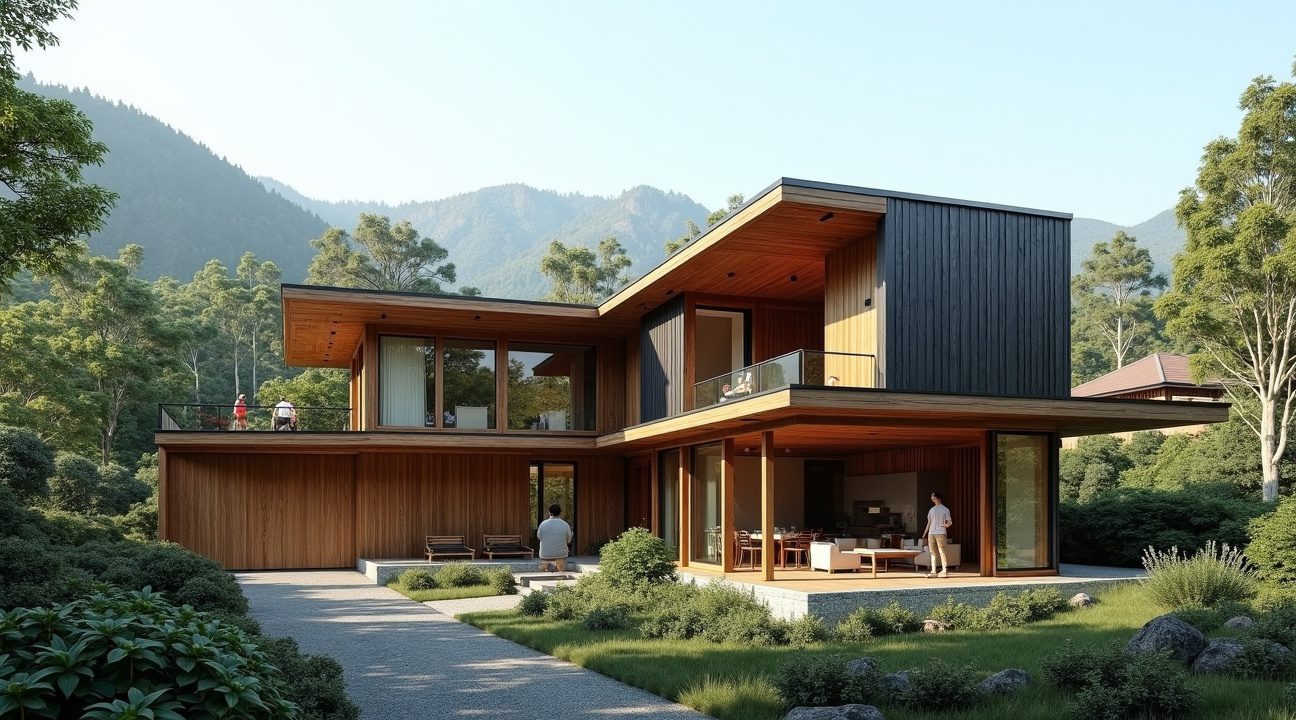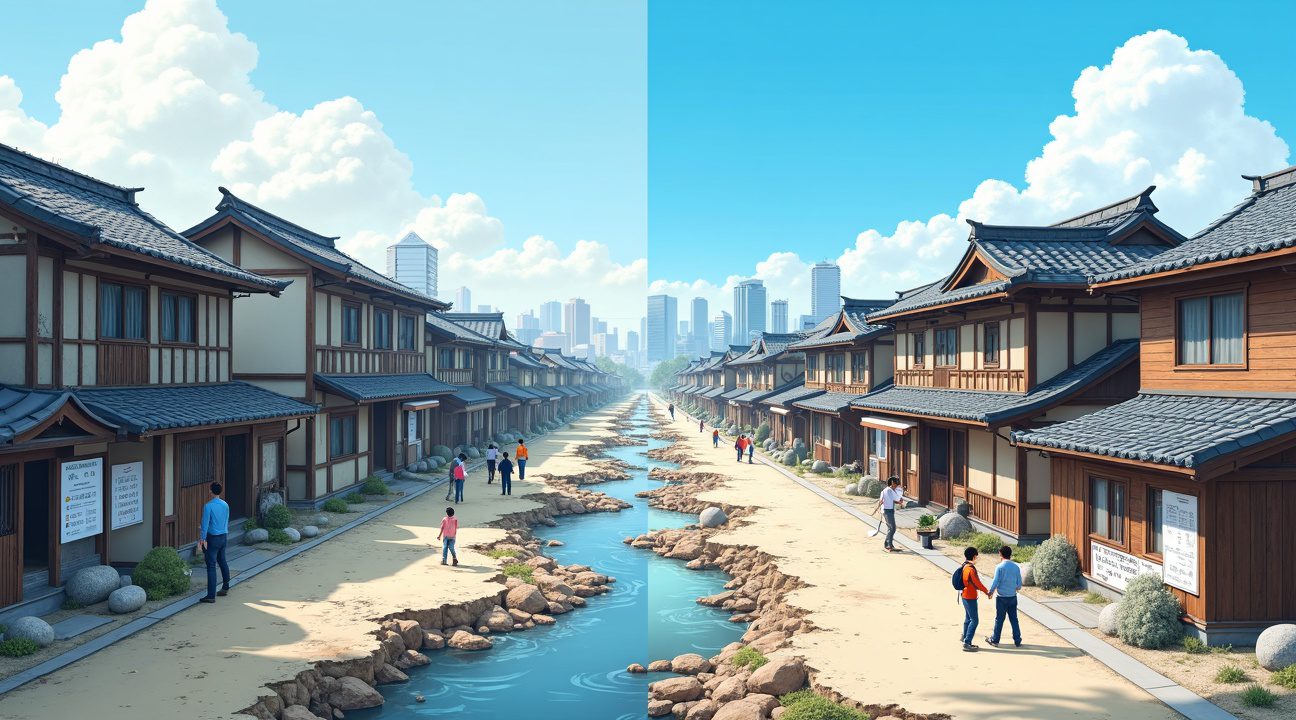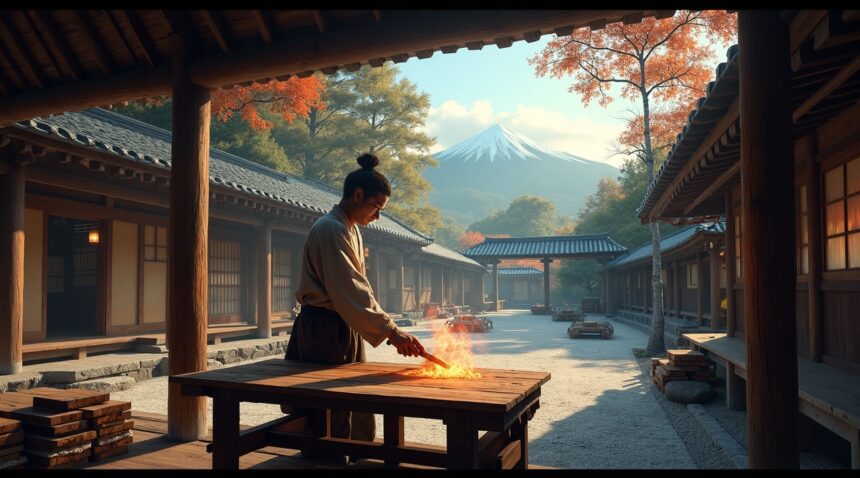Japan employs time-honored wood burning techniques such as shou sugi ban to enhance the strength and resilience of timber used in construction, blending traditional knowledge with contemporary engineering in one of the world’s most seismically active regions.
Key Takeaways
- Shou sugi ban charring technique: This method creates a protective carbon layer on wood surfaces that enhances weather resistance and offers some degree of fire protection. However, scientific studies indicate it does not reliably prevent decay or significantly minimize fire risk as commonly believed.
- Strategic forest management: Japan maintains environmental sustainability by harvesting only 0.45% of annually grown trees, ensuring a renewable timber supply that supports the construction sector.
- Modern engineering methods: Traditional Japanese joinery is effectively integrated with contemporary practices such as steel reinforcements and flexible foundation systems, allowing wooden structures to absorb and adapt to seismic movements rather than resisting them rigidly.
- Government building codes: Building standards have evolved to include traditional walling methods such as Dozo and Shinkabe. These earth-plaster wall systems are now officially recognized as effective fire protection solutions.
- Seismic vulnerability remains significant: An estimated 50 million wooden homes in Japan still do not meet current earthquake safety standards, underscoring the need for continued retrofitting initiatives and public safety improvements.
To explore more about traditional Japanese architectural resilience and sustainability practices, visit this detailed article on shou sugi ban by ArchDaily.
Shou Sugi Ban Explained
Shou sugi ban (焼杉板) represents one of Japan’s most distinctive traditional wood treatment methods, charring cedar boards to create a protective surface that has captivated architects and builders worldwide. Also known as yakisugi, this technique emerged during the Edo period in the 1600s around the Tokyo area, where craftsmen discovered that controlled burning could transform ordinary cedar wood into something more resilient.
The Traditional Process and Its Purposes
Cedar boards receive careful charring treatment through controlled burning, creating the characteristic blackened surface that defines this ancient technique. Traditional practitioners developed this method to address multiple challenges in Japanese construction, where wooden structures faced constant threats from the elements and various environmental factors.
The primary goals of shou sugi ban include several key benefits:
- Improving overall durability of exterior wood surfaces
- Enhancing resistance to fire damage
- Preventing decay and rot in humid conditions
- Deterring insects and other wood-boring pests
- Increasing weather resilience against rain and moisture
Craftsmen typically use sugi (Japanese cedar) for this process because of its favorable burning characteristics and availability throughout Japan. The charring creates a carbon layer on the wood’s surface, which traditional builders believed would act as a protective barrier against various environmental threats.
Modern Scientific Understanding
Recent scientific evaluations have provided a more nuanced understanding of shou sugi ban’s actual protective capabilities. While the technique remains popular for aesthetic and cultural reasons, controlled testing reveals that the charred surface doesn’t consistently deliver all the protective benefits traditionally attributed to it.
Scientific analysis shows no reliable improvement in resistance to decay caused by rot fungi, challenging long-held beliefs about the technique’s preservative qualities. Similarly, tests demonstrate no marked reduction in fire risk compared to untreated wood, despite the counterintuitive nature of using fire to prevent fire damage.
However, the charred surface does offer some degree of weatherproofing, which explains why many traditional Japanese buildings featuring yakisugi have withstood decades of exposure to harsh weather conditions. This weatherproofing capability stems from the carbon layer’s ability to repel water and reduce moisture penetration into the underlying wood fibers.
The gap between traditional beliefs and modern testing doesn’t diminish the cultural significance of this surface treatment method. Japanese builders continue to employ shou sugi ban not only for its modest protective qualities but also for its distinctive appearance and connection to historical building practices. The technique reflects the same attention to detail and respect for craftsmanship that characterizes many aspects of Japanese culture, similar to how Japanese spectators maintain stadiums after sporting events.
Contemporary applications of yakisugi often focus on the aesthetic appeal of the charred wood surface rather than expecting dramatic improvements in fire resistance or decay prevention. Architects appreciate the rich, dark patina that develops over time, while builders value the technique’s ability to create distinctive exterior finishes that age gracefully.
Understanding both the historical context and modern scientific findings allows builders to make informed decisions about when and how to implement this traditional Japanese technique in contemporary construction projects.

Why Wood Dominates Japanese Home Construction Despite Earthquake Risks
Japan’s commitment to wooden construction defies conventional wisdom about earthquake-resistant building practices. Despite experiencing seismic activity three times more frequently than the United States and five times more than the United Kingdom, timber comprises roughly 59% of new residential buildings as of 2024—a significant increase from 43% in 2006. This dramatic shift reveals a counterintuitive approach to construction in one of the world’s most earthquake-prone regions.
The statistics paint a compelling picture of Japan’s unwavering faith in wood. Wooden housing units made up 57.1% of all construction starts in 2024, demonstrating that builders and homeowners continue choosing timber over concrete and steel alternatives. This preference persists even as the country endures constant seismic threats that would typically drive construction standards away from combustible materials.
Strategic Forest Management Drives Construction Choices
Japan’s approach to wooden construction stems partly from exceptional forest management practices that make timber both abundant and sustainable. The country harvests only 0.45% of annually grown trees, creating a renewable resource that supports the construction industry without depleting natural reserves. This conservative harvesting approach ensures a steady supply of quality timber while maintaining ecological balance.
Forest stewardship in Japan operates on decades-long cycles, with carefully planned reforestation programs that replace harvested timber faster than it can be consumed. The result is a construction material that’s both environmentally responsible and economically viable for long-term housing development.
Engineering Excellence Transforms Wood Into Earthquake Protection
Japanese engineers have revolutionized wooden construction through advanced techniques that actually enhance earthquake resistance rather than compromise it. Traditional joinery methods, refined over centuries, create flexible connections that allow structures to move with seismic forces instead of fighting against them. Modern adaptations of these techniques incorporate steel reinforcements and engineered lumber products that maintain wood’s flexibility while adding strength.
The burning process mentioned in traditional Japanese construction—called “shou sugi ban” or “yakisugi”—serves multiple purposes beyond aesthetics. Charring the wood’s surface creates several protective benefits that contribute to structural integrity:
- Enhanced fire resistance through controlled carbonization
- Improved pest and rot resistance from the charred layer
- Increased dimensional stability that reduces warping and splitting
- Extended lifespan that can exceed untreated wood by decades
- Superior moisture management that prevents structural degradation
These burned wood techniques demonstrate how Japanese culture embraces what Japanese spectators cleaning stadiums after games exemplifies—turning apparent contradictions into practical advantages through disciplined application of traditional wisdom.
Contemporary Japanese wooden construction combines these time-tested burning techniques with modern engineering standards. Base isolation systems, seismic dampers, and flexible foundation designs work together with treated timber to create buildings that bend without breaking during earthquakes. The wood’s natural flexibility becomes an asset rather than a liability when properly engineered and treated.
Building codes in Japan have evolved to accommodate wooden construction while ensuring safety standards that often exceed those found in regions with less seismic activity. Multi-story wooden buildings now incorporate advanced fire suppression systems, engineered lumber products, and hybrid construction methods that blend wood with steel and concrete elements where additional strength is needed.
The economic advantages of wooden construction also drive its continued popularity. Timber remains more affordable than steel or concrete alternatives, particularly when factoring in Japan’s sustainable forestry practices that keep raw material costs stable. Construction timelines for wooden buildings are typically shorter, reducing labor costs and allowing families to move into new homes more quickly.
Regional preferences play a significant role in maintaining wood’s dominance. Many Japanese homeowners associate wooden construction with comfort, breathability, and connection to natural environments. These cultural factors, combined with proven engineering solutions, create market demand that supports continued innovation in wooden building techniques.
Japan’s forest industry benefits from this construction preference, creating a virtuous cycle where sustainable forestry practices support domestic construction needs while reducing reliance on imported building materials. This approach strengthens both environmental stewardship and economic independence in the construction sector.

Traditional Fire Protection Methods Beyond Charred Wood
Japanese builders have developed sophisticated fire protection techniques that extend far beyond wood charring alone. Earth-plaster wall methods such as Dozo and Shinkabe represent centuries of refined craftsmanship that continues to protect wooden structures today.
Earth-Plaster Wall Construction Techniques
Dozo and Shinkabe construction methods create powerful fire barriers by reinforcing timber frames with carefully mixed soil and plaster compositions. These techniques involve applying multiple layers of earth-based materials directly onto wooden framework, forming thick protective walls that resist ignition and slow fire spread. The mixture typically combines local clay, sand, chopped straw, and specialized binding agents that create a durable, fire-resistant surface.
Shinkabe construction specifically refers to walls where the timber framework remains visible, with earth-plaster filling the spaces between wooden posts and beams. Dozo methods, on the other hand, completely cover the timber structure with thick earthen walls, creating an even more substantial fire barrier. Both approaches have proven their effectiveness over hundreds of years in protecting traditional Japanese buildings.
Official Recognition and Modern Applications
Japan’s Building Standards Law officially recognizes these traditional construction approaches as legitimate fire protective constructions, giving them equal standing with modern fire-resistant materials. This legal recognition validates what builders have known for generations — that properly executed earth-plaster walls provide exceptional fire protection while maintaining structural integrity.
These methods offer remarkable sustainability benefits that align with modern environmental consciousness:
- Local sourcing: Materials are typically sourced from the nearby environment, minimizing transport emissions.
- Low environmental impact: Earth-plaster walls are biodegradable and recyclable, reducing construction waste.
- Support for heritage: Construction techniques contribute to the preservation of architectural identity and cultural integrity.
These construction techniques contribute significantly to conserving historical townscapes, particularly in areas where traditional architecture defines the cultural character. Much like the cultural dedication seen in Japanese community practices, these building methods reflect deep respect for preserving cultural heritage.
Resource recycling plays a crucial role in these traditional methods, as damaged earth-plaster walls can be removed, remixed, and reapplied without generating significant waste. Historic preservation efforts across Japan rely heavily on maintaining these traditional construction techniques, ensuring that centuries-old buildings continue to stand while meeting modern safety standards.
The combination of fire protection, environmental sustainability, and cultural preservation makes earth-plaster wall construction an increasingly attractive option for modern builders seeking alternatives to conventional materials. These time-tested methods prove that traditional knowledge often provides solutions that modern technology struggles to match in terms of effectiveness, sustainability, and cultural value.
The Reality of Japan’s Earthquake-Vulnerable Housing Stock
Japan’s housing landscape presents a striking contradiction. While the country leads innovation in earthquake-resistant construction, approximately 50 million wooden houses across the nation fail to meet current seismic regulations or structural calculation requirements. This massive vulnerability stems from decades of construction practices that predated today’s stringent safety standards.
The magnitude of this challenge becomes clear when examining older building practices. Before modern seismic standards took effect, Japanese construction relied heavily on traditional methods that couldn’t withstand the intense ground motion of major earthquakes. These structures lacked proper structural calculations and adequate reinforcement systems that are now considered essential for earthquake survival.
Lessons from the 1995 Kobe Earthquake
The devastating 1995 Kobe earthquake served as a wake-up call for Japan’s construction industry. This catastrophic event exposed the fatal weaknesses in older wooden structures, with thousands of buildings collapsing under seismic forces. The disaster highlighted how insufficient building standards had left entire neighborhoods defenseless against earthquake damage. Most of the casualties occurred when traditional wooden houses collapsed, crushing occupants who had trusted these structures to protect them.
Following Kobe, Japan implemented sweeping changes to its building codes. The government recognized that cosmetic updates wouldn’t suffice – fundamental shifts in structural design and material standards were necessary. Cultural values of responsibility and community safety drove these comprehensive reforms forward.
Modern Efforts to Address Structural Deficiencies
Current government policy focuses on bringing newer wooden structures into compliance with advanced seismic standards. The process involves retrofitting existing buildings and implementing stricter requirements for new construction. Engineers now conduct detailed structural calculations before approving any wooden building project, ensuring that seismic resistance meets or exceeds minimum safety thresholds.
The government has established several key initiatives to address this housing vulnerability:
- Mandatory seismic evaluations for older wooden structures in high-risk areas
- Financial incentives for homeowners who upgrade their buildings to meet current standards
- Enhanced training programs for construction workers and architects on modern seismic design principles
- Stricter enforcement of building codes during construction inspections
- Public education campaigns about earthquake preparedness and structural safety
These efforts extend beyond Japan’s borders, as the country shares its hard-earned expertise with other earthquake-prone nations. Japanese engineers work with international organizations to promote best practices in seismic construction, particularly for wooden structures that remain popular in many countries.
Progress continues to be measured against the backdrop of ongoing seismic activity. Japan experiences thousands of earthquakes annually, providing constant reminders of why structural safety can’t be compromised. Each tremor tests the effectiveness of both old and new construction methods, revealing which buildings will protect their occupants and which might fail during the next major event.
The challenge of upgrading Japan’s vulnerable housing stock requires sustained commitment from both government and private sectors. While new construction must meet rigorous standards, the millions of older wooden houses represent an ongoing risk that demands immediate attention. Building standards continue evolving as engineers learn from each earthquake, incorporating new technologies and materials that enhance seismic resistance without sacrificing the cultural preference for wooden construction.
This ongoing transformation reflects Japan’s determination to balance traditional building materials with cutting-edge safety technology. The country’s experience demonstrates that wooden houses can indeed provide excellent earthquake protection when designed and constructed according to modern seismic principles, but only when proper structural calculations and building standards guide every aspect of construction.

Japan’s Changing Housing Market and Timber Industry Economics
Japan’s housing market has undergone significant transformation since reaching its peak of over 50 million units in 1998. Housing construction has experienced a dramatic slowdown, with new builds declining from 1.54 million in 1994 to just 818,514 in 2023. Despite this reduction in overall construction activity, timber remains a cornerstone of Japanese building practices.
The decline in housing starts reflects several economic and demographic factors affecting Japan’s construction sector. An aging population and slower household formation have reduced demand for new residential construction. However, the timber industry continues to adapt and find opportunities within this changing landscape.
Policy Support and Workforce Development
Recent policy changes have strengthened the timber construction sector through strategic workforce initiatives. Updated visa regulations now promote skilled immigration specifically targeting the timber and forestry workforce, addressing labor shortages that have historically challenged the industry. These policy adjustments recognize the critical role of specialized craftspeople in maintaining Japan’s traditional wood construction methods.
Domestic forestry initiatives have gained momentum as Japan prioritizes sustainable building materials. The government’s commitment to renewable resources has created new opportunities for local timber producers, even as overall construction volumes decrease. Forest management programs now emphasize sustainable harvesting practices that support long-term industry growth while maintaining environmental standards.
Market trends show growing international demand for Japanese timber expertise and techniques. The focus on sustainable forestry practices aligns with global environmental concerns, positioning Japan’s timber industry for potential export opportunities. Construction companies increasingly value the environmental benefits of wood construction, which helps offset carbon emissions compared to steel and concrete alternatives.
The economics of timber construction have become more favorable as technology advances reduce processing costs. Modern milling techniques and improved treatment methods make wood preparation more efficient, helping maintain competitiveness despite higher labor costs. Investment in forestry infrastructure continues to support the industry’s economic viability.
Building policies have evolved to encourage sustainable construction practices, with timber construction receiving favorable treatment in certain regulatory frameworks. These policy shifts recognize wood’s role in Japan’s environmental goals while supporting domestic forestry operations. The emphasis on renewable materials creates a stable foundation for continued timber industry growth, even as overall housing construction volumes remain below historical peaks.
Japan’s approach demonstrates how traditional materials can adapt to modern economic realities. Cultural practices in Japan often influence policy decisions, and the timber industry benefits from this cultural alignment with sustainable building practices.

Sources:
Wood Central – Japan’s Lost Decades: Housing Starts Dive to Half of 1994 Levels
Statista – Japan Share Wooden Buildings Housing Construction Starts
USDA Foreign Agricultural Service – Japanese Housing Stock in 1998
The Worldfolio – Safe and Reliable Wooden Housing for Comfortable Living
USDA Forest Service – Treesearch/61142


